Introduction
In the late 1990s, Mitsubishi had a fairly unknown line of portable computers called the Amity (stylized as AMiTY). It included machines in several form factors: the Amity CP/VP was an early form of Tablet PC, with an active WACOM tablet digitizer on the screen, but there was also an even more unusual subnotebook: The Amity CN.
Amity CN
Subnotebooks themselves weren’t unusual for the time (see IBM ThinkPad 500, Chandra, and many other articles on this site), but this one was far smaller than most. Measuring in at 9 x 6.5 x 1.25 inches (22 x 16.5 x 3.2 cm) and weighing only 2 lb 9.6 oz (1180 g) with the Lithium-Ion battery pack installed, this machine was even more lightweight than most other “ultraportables” of the era.
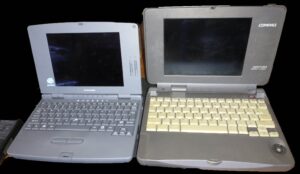
(Amity CN on left, Compaq Contura Aero on right – and the Aero was considered small!)
The Amity CN runs a fanless Pentium 1 at 133 MHz by default (with generous configuration options for processor speed, and other power-saving factors, in the BIOS Setup). 16 MB of memory is built-in, but you can expand this via a single low-profile SODIMM slot under the keyboard. I expanded mine to 48 MB with a 32 MB stick; although my Amity CP from the same era accepted a 128 MB stick, I wasn’t able to get this to work on the CN. Mine was manufactured in 1997 according to the date codes on the ICs inside of the unit.
For power, there is a 10.8V 1350mAh Lithium Ion battery. This appears to be a custom-made battery pack, in the shape of an elongated “D”, and it perfectly fits within the battery compartment (which screws onto the base of the machine). The battery connects with two probe-style terminals, something I’ve never seen on a laptop.
The screen is a glossy, color, passive-matrix LCD (an extremely rare combination!) running at 640×480. It’s bright enough and crisp enough, but it’s not active-matrix, so any movement causes fairly severe motion blur. Combine that with the fast processor, and you can play DOOM at perfect frame rates with a lot of motion blur, also an unusual combination as by the end of the 1990s, most laptop screens were active-matrix.
For sound, the Amity CN has an ESS ES1878 AudioDrive built-in. It does have an internal speaker, but it’s monaural.
On the left of the machine, you will find the headphone and microphone jacks, along with the power button. On the right are two PCMCIA non-CardBus (PC Card) slots. On the rear, there is an infrared blaster/receiver, along with a PS/2 combination port (labeled for both Mouse and Keyboard) the traditional Serial/Parallel/Video and DC Input jacks. It’s worth mentioning that the access door for the Serial/Parallel/Video ports flips 180 degrees, allowing you to use it as a “foot” to prop up the entire machine at a slight angle! This is neat, but nowhere near as over-engineered as the plastic pieces on the Amity CP (see below).
Amity CP
The Amity CP is slightly less portable than its CN relative. While the weight is similar to the CN (with both batteries and hard drive: 2 lbs 13.75 oz, or 1300 g), it’s a tad larger. It’s closer to the size of a traditional (non-ultraportable) notebook of the era: 10 x 7 x 1.5 inches (25.5 x 17.75 x 3.8 cm).
There are several pieces of movable plastic on the rear of the machine’s case that, when combined with the screen lid (which flips open, up and around to the back of the machine) allow you to operate the machine at several angles of incline (vs lying flat):
- A small rectangular piece near the top folds downward, and a smaller piece extends rightward out of that piece. The smaller piece then latches into a recess in the case (not very reclined).
- A very large rectangular piece taking up most of the rear folds downward (reclined), and you can optionally pull a long plastic piece out of that (very reclined).
Here are some pictures of what I’m talking about:
My Amity CP (manufactured in 1999 according to the ICs inside of the unit) has a 200 MHz processor, although the official spec sheet shows (archive.org) that it originally came with 166 MHz. The spec sheet also claims a maximum of 96 MB of RAM, but I was able to run mine with 160 MB by using a single 128MB SODIMM.
For power, it uses two “D”-shaped elongated Lithium Ion battery packs, each contributing 7.2V 1350mAh. Unlike the CN, you do not have to manually connect these to two probes; instead, you can just insert them and move a “gate” back and forth to lock them in place. This “gate” can be in the left position, which allows the rightmost battery to be removed, the right position, which allows the leftmost battery to be removed, or the middle, which keeps both locked in place. When running on battery power, both batteries are used simultaneously (in parallel), as opposed to being used in series. They have aged well; I get over an hour and a half of combined use on mine.
The screen is a matte, color, passive-matrix LCD with an active WACOM Digitizer over the top of it. It does have pressure sensitivity, but I wasn’t able to get any programs to recognize this (likely a driver issue). There is an array of buttons to the right of the screen (0-9, period, dash, backspace, enter, Esc/Alt/Ctrl/Tab, and arrow keys). These appear to have NKRO (you can press as many as you want simultaneously), and I tested this by playing a race of the videogame Road Rash using only these buttons (and won on the first try, despite the motion blur of the passive-matrix screen). It was actually fun to play it this way; given the digitizer, however, this machine is obviously most ideal for Solitaire.
There is a single USB port on the top of the machine, along with a Contrast wheel for the screen, and the dual battery slots. On the right, you can find headphone, microphone, and DC Input jacks, along with a PS/2 port (labeled for both Mouse and Keyboard) as well as the recessed cavity for the WACOM stylus. There is also a plastic blank with a cutout for what I believe is an optional modem. On the bottom is an infrared blaster/receiver. On the left is an expansion port, and two PCMCIA slots that I confirmed are CardBus-capable.
The machine has an ESS ES1879 AudioDrive built-in, which I have always been fond of. Naturally, it doesn’t sound the best through the built-in monaural speaker, but it’s pretty impressive with a good pair of headphones.
Common Issues
The Achilles’ Heel of both of my Amity machines has been the CMOS/clock battery. This is soldered on, and once it runs out, the machine will no longer boot, or POST at all. Turning the machine on will result in a 1-4-2-1 beep code, and no video output or anything else! Since the battery is non-rechargeable, you cannot just leave the machine on for a few minutes to charge the battery, and then reboot it. However, this is also an advantage: Since the machine does not try to recharge the clock battery, you can simply clip the leads of the battery and solder a CR2032 holder to the pads, without worrying about a diode to prevent charging. On both my Amity CP and CN, this modification brought the machine back to life immediately!
(Pictures of Amity CN’s CMOS battery replacement. Click thumbnails for larger images.)
(Pictures of Amity CP’s CMOS battery replacement. Click thumbnails for larger images.)

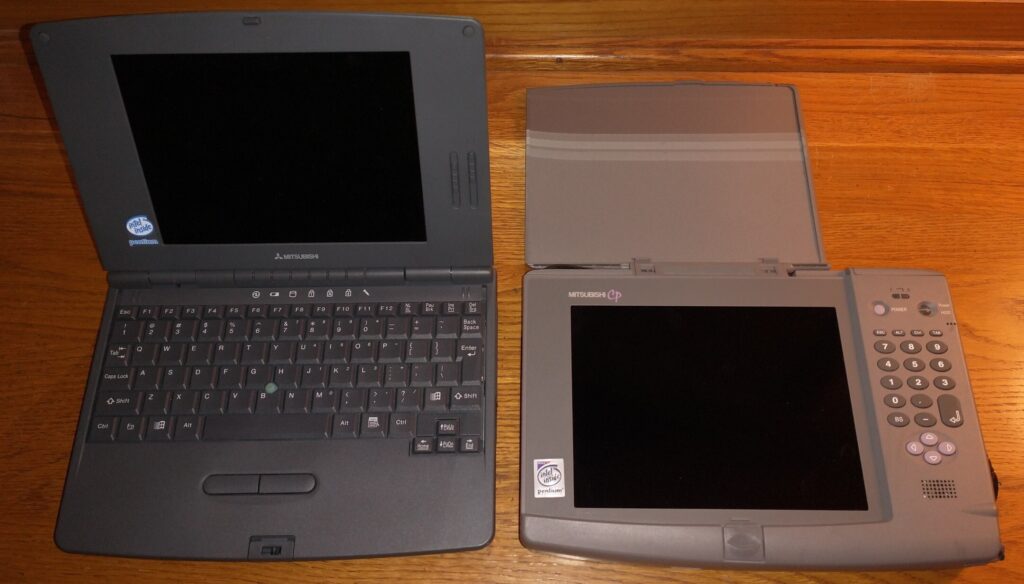
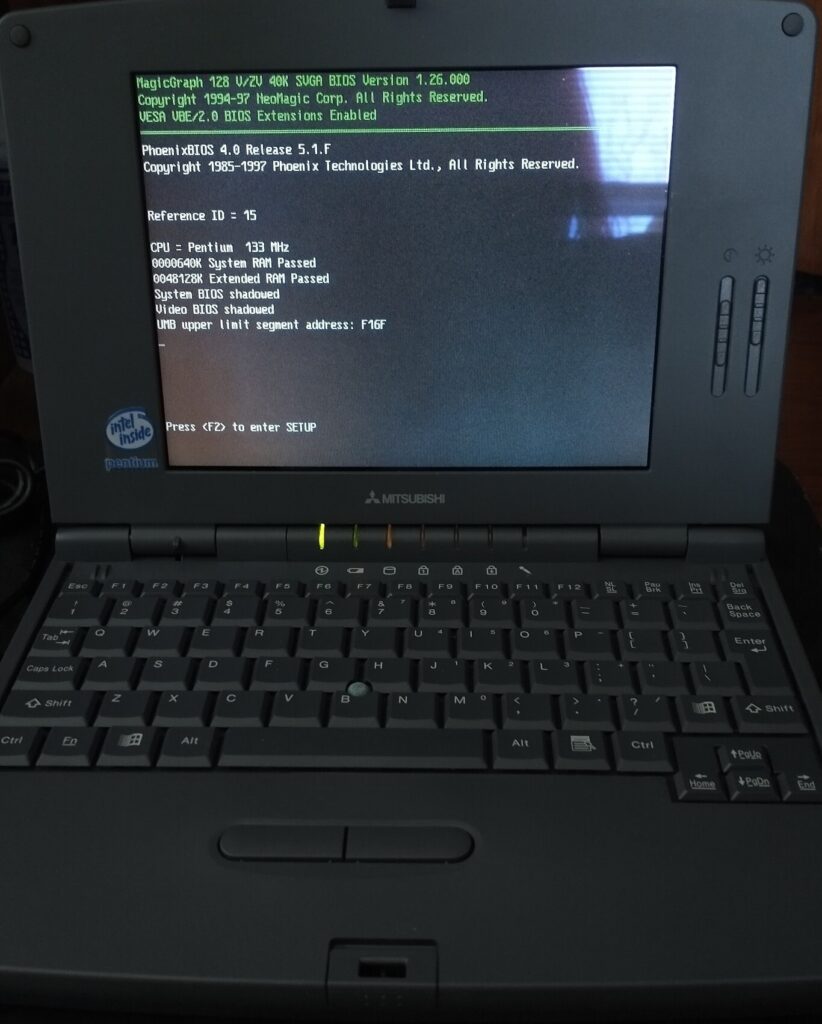

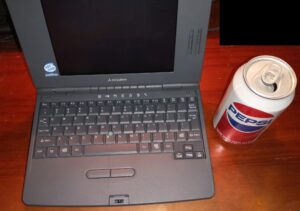
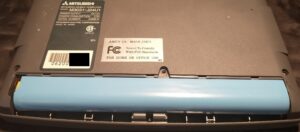
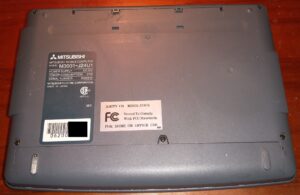
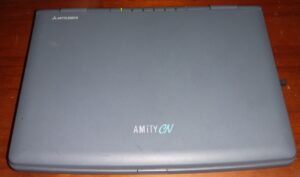
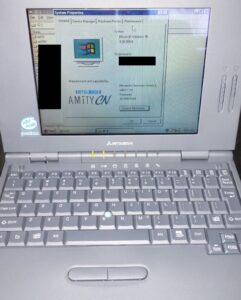
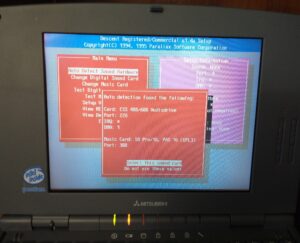

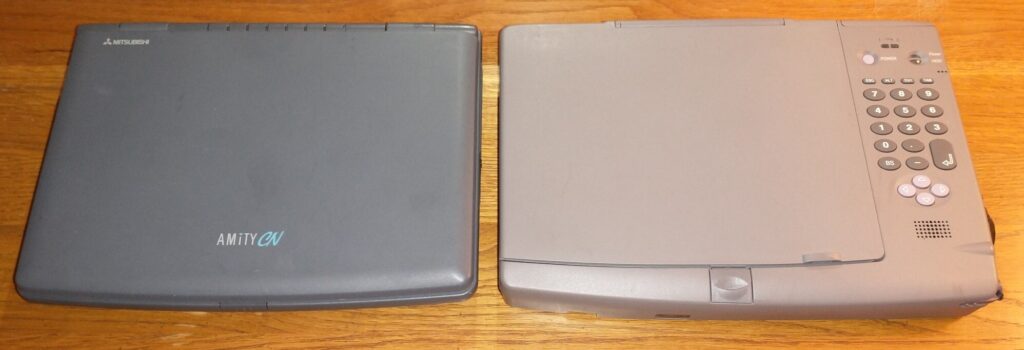
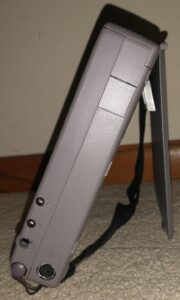
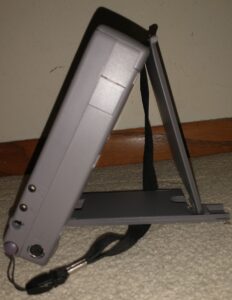
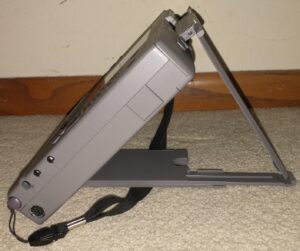
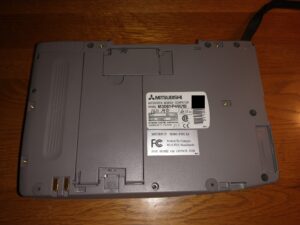
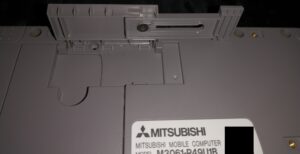
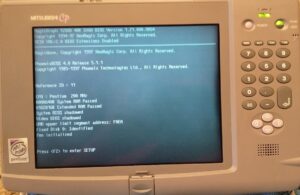
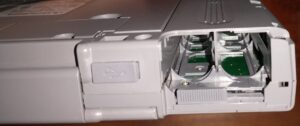
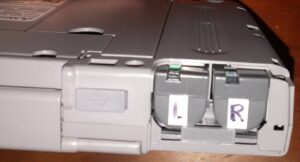
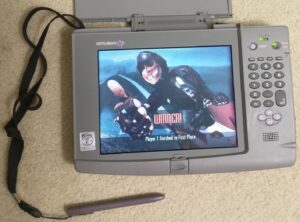
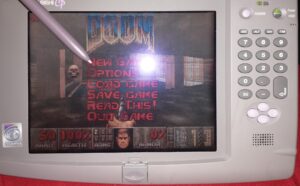
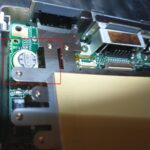
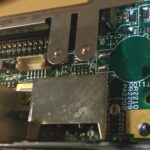

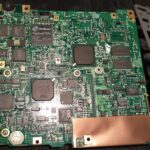
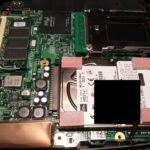
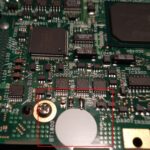
I have a CN and just tried to boot it up and got this exact beep code. Thank heavens I found this post! Info on the CN is very difficult to find. Would you happen to know if there is a PDF of the manual and/or schematics out there somewhere?
On the CMOS battery issue itself, is this the type of battery that leaks its guts over the interior like on some older PCs? Also, is it possible to see a pic or two of the 2032 holder in place? I’m a newbie at electronics repair and soldering and would like to see what yours looks like so I can get it right.
Thanks for your help and posting about the CN!
Hi Michael,
I’m glad I could help! Fortunately, this is not the kind of battery that leaks (often, CMOS batteries that are soldered in like this are rechargeable, and those are the ones that tend to leak. Neither Amity has a rechargeable CMOS battery).
I found a product on eBay that was very similar to this: https://www.esquareparts.com/parts/battery-holder/
It’s a slim, clamshell-style holder with an ON/OFF switch. I prefer these, as I can wait to turn it on until the very last minute, in case I accidentally short something while trying to fit it in the laptop. It was a bit of a tight fit in the Amity CN, but I made it work. The Amity CP has more free space inside. The small picture at the bottom of the article (with the red/black wires) should give you an idea of what soldering needs to be done.
I just now saw your reply! I’ve ordered the part and will update once I’m able to attempt repair. Thank you!
Thank you so much, I have been trying to fix my Amity CN for years. I bought it brand new in box on eBay over a decade ago. Not terribly long afterward, it started the beep sequence that you described, and I’ve had it shelved in almost perfect condition all of these years since. I even bought a parts unit when I found one, thinking that the RAM had gone bad, but this unit also refused to post.
What an odd design… normally a computer simply gives a CMOS error when the battery dies, and allows you to bypass. I have a 5 pack of the coin batteries and the little holders on order. Hopefully, it’s not too difficult to open the unit up.
i used to have the CN in the past but it died and i lost it long ago. i know it’s a rare laptop but i always keep my eye peeled incase i find one for sale. i think it was one of the smallest awesome computers i ever had. used to have the full kit of stuff to add to it as well. CD/FLoppy via the parallel port and 10/100 networking via the PCMICA card slot. the last days i remembered with my machine was that i was about to setup for network star craft broad war at the local club and it refused to boot. (probably for the reason in this post now i think of it). if anyone knows of a CN for sale feel free to hit me up. just google my name and you can find me in many places.
Good news I have found one and it’s on the way hopefully!
now i have it i did the same cmos fix and it worked right away! great little laptop. have many plans for it!
Excellent! Another one of these great little machines saved. Thanks for the update!
My Great Uncle passed away and he had an Amity CN which I now have. It has all the external accessories also. I never powered it up. I came across it sitting in my closet so I decided to power it up but the battery was dead and unable to charge it either. Is there another battery option out there to use?
Even without a battery pack installed, the Amity should still function, unless the internal clock battery is bad (as described above), in which case you would only get a power light and some beeps. As for the battery pack, it is unfortunately proprietary. However, you could use an external power bank with this (or any other laptop) if you wanted to use it away from a power outlet. Something like this would work with the Amity, as long as it’s set for 16 Volts (and has a tip/adapter that physically fits the laptop, which you can buy separately): https://www.amazon.com/Krisdonia-Portable-TSA-Approved-25000mAh-Smartphone/dp/B074PQBRJV